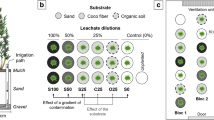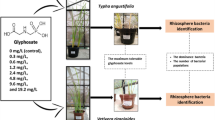Abstract
Trichloroethylene (TCE) is a widespread soil and groundwater pollutant and clean-up is often problematic and expensive. Phytoremediation may be a cost-effective solution at some sites. This study investigates TCE degradation by willows (S. viminalis) and willows inoculated with three strains of B. cepacia (301C, PR1-31 and VM1330-pTOM), using chloride formation as an indicator of dehalogenation. Willows were grown in non-sterile, hydroponic conditions for 3 weeks in chloride-free nutrient solution spiked with TCE. TCE was added weekly due to rapid loss by volatilization. Chloride and TCE in solution were measured every 2–3 days and chloride and metabolite concentrations in plants were measured at test termination. Based on transpiration, no tree toxicity of TCE exposure was observed. However, trees grown in chloride-free solution showed severely inhibited transpiration. No or very little chloride was formed during the test, and levels of chloride in TCE-exposed trees were not elevated. Chloride concentrations in chloride containing TCE-free nutrient solution doubled within 23 days, indicating active exclusion of chloride by root cell membranes. Only traces of TCE-metabolites were detected in plant tissue. We conclude that TCE is not, or to a limited extent (less than 3%), aerobically degraded by the willow trees. The three strains of B. cepacia did not enhance TCE mineralization. Future successful application of rhizo- and phytodegradation of TCE requires measures to be taken to improve the degradation rates.




Similar content being viewed by others
References
Adams P (1991) Effects of increasing the salinity of the nutrient solution with major nutrients or sodium chloride on the yield, quality and composition of tomatoes grown in rockwool. J Hortic Sci 66:201–207
Anderson TA, Walton BT (1995) Comparative fate of [14C] trichloroethylene in the root zone of plants from a former solvent disposal site. Environ Toxicol Chem 14:2041–2047
Anderson TA, Guthrie EA, Walton BT (1993) Bioremediation in the rhizosphere. Environ Sci Technol 27:2630–2636
Baduru KK, Trapp S, Burken JG (2008) Direct measurement of VOC diffusivities in tree tissues: impacts on tree-based phytoremediation. Environ Sci Technol 42:1268–1275
Barac T, Taghavi S, Borremans B, Provoost A, Oeyen L, Colpaert JV, Vangronsveld J, van der Lelie D (2004) Engineered endophytic bacteria improve phytoremediation of water-soluble, volatile, organic pollutants. Nat Biotechnol 22:583–588
Blank O-H (2009) Is there a need for the use of chloride-free mineral fertilizers for currant as a common berry fruit. Dissertation, University of Hohenhiem
Burken J (2004) Uptake and metabolism of organic compounds: green-liver model. In: McCutcheon SC, Schnoor JL (eds) Phytoremediation: transformation and control of contaminants. John Wiley & Sons, New Jersey, pp 59–84
Cakmak I, Marschner H (1992) Magnesium deficiency and high light intensity enhance activities of superoxide dismutase, ascorbate peroxidase, and glutathione reductase in bean leaves. Plant Physiol 98(4):1222–1227
Cello FD, Bevivino A, Chiarini L, Paffetti D, Tabacchioni S, Dalmastri C (1997) Biodiversity of a Burkholderia cepacia population isolated from the maize rhizosphere at different plant stages. Appl Environ Microbiol 63:4485–4493
Chappell J (1997) Phytoremediation of TCE using populus. Status report prepared for the US EPA Technology Innovation Office under a National Network of Environmental Management Studies Fellowship. https://clu-in.org/download/studentpapers/phytotce.pdf. Accessed 4 July 2016
Chard BK, Doucette WJ, Chard JK, Bugbee B, Gorder K (2006) Trichloroethylene uptake by apple and peach trees and transfer to fruit. Environ Sci Technol 40:4788–4793
Clausen LPW, Karlson UG, Trapp S (2015) Phytotoxicity of sodium fluoride and uptake of fluoride in willow trees. Int J Phytoremediat 17:369–376
Cunningham SD, Berti WR (1993) Remediation of contaminated soils with green plants: an overview. In Vitro Dev-Pl 29:207–212
Danish Natural Environment Portal (DNEP) (Danmarks Miljøportal) (2016) Database of V1 and V2 registered sites in Denmark. Written communication. Information available at inquiry
Deavers K, Macek T, Karlson UG, Trapp S (2010) Removal of 4-chlorobenzoic acid from spiked hydroponic solution by willow trees (Salix viminalis). Environ Sci Pollut Res 17:1355–1361
Dietz AC, Schnoor JL (2001) Phytotoxicity of chlorinated aliphatics to hybrid poplar (Populus deltoides× nigra DN34). Environ Toxicol Chem 20:389–393
Folsom BR, Chapman PJ, Pritchard PH (1990) Phenol and trichloroethylene degradation by Pseudomonas cepacia G4: kinetics and interactions between substrates. Appl Environ Microbiol 56:1279–1285
Fox BG, Borneman JG, Wackett LP, Lipscomb JD (1990) Haloalkene oxidation by the soluble methane monooxygenase from Methylosinus trichosporium OB3b: mechanistic and environmental implications. Biochemistry-US 29:6419–6427
Gerhardt KE, Huang X-D, Glick BR, Greenberg BM (2009) Phytoremediation and rhizoremediation of organic soil contaminants: potential and challenges. Plant Sci 176:20–30
Glensvig D, Buch C, Abildgaard A, Mortensen P (2008) Mapping of adjuvants and additives at Danish dry cleaners past and present. Translated from: Kortlægning af hjælpe-og tilsætningsstoffer i danske renserier før og nu. The Danish environmental protection agency
Grieve AM, Walker RR (1983) Uptake and distribution of chloride, sodium and potassium ions in salt-treated citrus plants. Aust J Agric Res 34:133–143
Hoekstra EJ, de Leer EW (1993) Natural production of chlorinated organic compounds in soil. Contam Soils 2:215–224
International Organization for Standardization (ISO) (1997) Water quality—fresh water algal growth test with Scenedesmus subspicatus and Raphidocelis subcapitata. ISO Standard 8692. International Organization for Standardization, Geneve
James CA, Xin G, Doty SL, Muiznieks I, Newman L, Strand SE (2009) A mass balance study of the phytoremediation of perchloroethylene-contaminated groundwater. Environ Pollut 157:2564–2569
Juuti S, Hoekstra EJ (1998) The origins and occurrence of trichloroacetic acid. Atmos Environ 32:3059–3060
Kang JW, Doty SL (2014) Cometabolic degradation of trichloroethylene by Burkholderia cepacia G4 with poplar leaf homogenate. Can J Microbiol 60:487–490
Larsen M, Burken J, Macháčková J, Karlson UG, Trapp S (2008) Using tree core samples to monitor natural attenuation and plume distribution after a PCE spill. Environ Sci Technol 42:1711–1717
Larsen M, Trapp S, Pirandello A (2004) Removal of cyanide by woody plants. Chemosphere 54:325–333
Larsen M, Ucisik AS, Trapp S (2005) Uptake, metabolism, accumulation and toxicity of cyanide in willow trees. Environ Sci Technol 39:2135–2142
Lewis TE, Wolfinger TF, Barta ML (2004) The ecological effects of trichloroacetic acid in the environment. Environ Int 30:1119–1150
Little CD, Palumbo AV, Herbes SE, Lidstrom ME, Tyndall RL, Gilmer PJ (1988) Trichloroethylene biodegradation by a methane-oxidizing bacterium. Appl Environ Microbiol 54:951–956
Marschner H (1995) Mineral nutrition of higher plants, 2nd edn. Academic Press, London, pp 396–404
McCarty PL (2010) Groundwater contamination by chlorinated solvents: history, remediation technologies and strategies. In: Stroo HF, Ward CH (eds) In situ remediation of chlorinated solvent plumes. Springer, New York, pp 1–4
McCutcheon SC, Schnoor JL (2004) Phytoremediation: transformation and control of contaminants. John Wiley & Sons, New Jersey
Munakata-Marr J, McCarty PL, Shields MS, Reagin M, Francesconi SC (1996) Enhancement of trichloroethylene degradation in aquifer microcosm bioaugmented with wild type and genetically altered Burkholderia (Pseudomonas) cepacia G4 and PR1. Environ Sci Technol 30:2045–2052
Newman L, Strand S, Duffy J, Ekuan G, Raszaj M, Shurtleff B, Wilmoth J, Heilman P, Gordon M (1997) Uptake and biotransformation of trichloroethylene by hybrid poplars. Environ Sci Technol 31:1062–1067
Newman LA, Wang X, Muiznieks IA, Ekuan G, Ruszaj M, Cortellucci R, Domroes D, Karscig G, Newman T, Crampton RS, Hashmonay RA, Yost MG, Heilman PE, Duffy J, Gordon MP, Strand SE (1999) Remediation of trichloroethylene in an artificial aquifer with trees: a controlled field study. Environ Sci Technol 33:2257–2265
Nielsen DL, Brock MA, Rees GN, Baldwin DS (2003) Effects of increasing salinity on freshwater ecosystems in Australia. Aust J Bot 51:655–665
Orchard BJ, Doucette WJ, Chard JK, Bugbee B (2000) Uptake of trichloroethylene by hybrid poplar trees grown hydroponically in flow-through plant growth chambers. Environ Toxicol Chem 19:895–903
Pan MJ, Rademan S, Kunert K, Hastings JW (1997) Ultrastructural studies on the colonization of banana tissue and Fusarium oxysporum f. sp. Cubense race 4 by the endophytic bacterium Burkholderia cepacia. J Phytopathol 145:479–486
Riley D, Barber SA (1971) Effect of ammonium and nitrate fertilization on phosphorus uptake as related to root-induced pH changes at the root-soil interface. Soil Sci Soc Am J 35:301–306
Schnoor JL, Licht LL, McCutcheon SC, Wolfe NL, Carreira LH (1995) Phytoremediation of organic and nutrient contaminants. Environ Sci Technol 29:318–323
Schöftner P, Watzinger A, Holzknecht P, Wimmer B, Reichenauer TG (2016) Transpiration and metabolisation of TCE by willow plants—a pot experiment. Int J Phytorem 18:686–692
Shang TQ, Doty SL, Wilson AM, Howald WN, Gordon MP (2001) Trichloroethylene oxidative metabolism in plants: the trichloroethanol pathway. Phytochemistry 58:1055–1065
Shields MS., Francesconi SC (1996) Microbial degradation of trichloroethylene, dichloroethylenes and aromatic pollutants. US patent office, pat. Nr. US5543317 A.
Stomp AM, Han KH, Wilbert S, Gordon MP (1993) Genetic improvement of tree species for remediation of hazardous wastes. In Vitro Dev-Pl 29:227–232
Trapp SAJ, Christiansen H (2003) Phytoremediation of cyanide-polluted soils. In: McCutcheon SC, Schnoor JL (eds) Phytoremediation: transformation and control of contaminants. John Wiley & Sons, New Jersey, pp 829–862
Trapp S, Feificova D, Rasmussen NF, Bauer-Gottwein P (2008) Plant uptake of NaCl in relation to enzyme kinetics and toxic effects. Environ Exp Bot 64:1–7
Trapp S, Karlson U (2001) Aspects of phytoremediation of organic pollutants. J Soils Sediments 1:37–43
Trapp S, Zambrano KC, Kusk KO, Karlson U (2000) A phytotoxicity test using transpiration of willows. Arch Environ Contam Toxicol 39:154–160
Ucisik AS, Trapp S (2006) Uptake, removal, accumulation, and phytotoxicity of phenol in willow trees (Salix viminalis). Environ Toxicol Chem 25:2455–2460
Ucisik AS, Trapp S (2008) Uptake, removal, accumulation, and phytotoxicity of 4-chlorophenol in willow trees. Arch Environ Contam Toxicol 54:619–627
Ucisik AS, Trapp S, Kusk KO (2007) Uptake, accumulation, phytotoxicity, and removal of 2,4-dichlorophenol in willow trees. Environ Toxicol Chem 26:1165–1171
Waters EM, Gerstner HB, Huff JE (1977) Trichloroethylene. I. An overview. J Toxicol Environ Health A 2:671–707
Weyens N, van der Lelie D, Taghavi S, Vangronsveld J (2009) Phytoremediation: plant-endophyte partnership take the challenge. Curr Opin Plant Biol 20:248–254
Wittlingerova Z, Machackova J, Petruzelkova A, Trapp S, Vlk K, Zima J (2013) One-year measurements of chloroethenes in tree cores and groundwater at the SAP Mimoň site, northern bohemia. Environ Sci Pollut Res 20:834–847
Xiao Y, Sun J, Liu F, Xu T (2016) Effects of salinity and sulphide on seed germination of three coastal plants. Flora 218:86–91
Yu XZ, Trapp S, Zhou PH, Chen L (2007) Effect of temperature on the uptake and metabolism of cyanide by weeping willows. Int J Phytoremediation 9:243–255
Yu XZ, Trapp S, Zhou PH, Hu H (2005) The effect of temperature on the rate of cyanide metabolism of two woody plants. Chemosphere 59:1099–1104
Yu XZ, Trapp S, Zhou PH, Wang C, Zhou X (2004) Metabolism of cyanide by Chinese vegetation. Chemosphere 56:121–126
Acknowledgements
The authors would like to thank Professor William J. Doucette, UWRL Associate Director, Utah State University, for valuable comments, suggestions, English proof reading, and for analyzing the TCE metabolite samples. Strains B. cepacia 301C and PR1-31 were kindly provided by S.C. Francesconi, and strain B. cepacia VM1330-pTOM by B. Borremans. We thank Susanne Kruse and Hanne Bøggild for assistance in the laboratory. Lastly, the author’s gratitude goes to the unknown reviewers who provided a lot of constructive comments which improved the manuscript considerably.
Author information
Authors and Affiliations
Corresponding authors
Additional information
Responsible editor: Philippe Garrigues
Electronic supplementary material
ESM 1
(DOCX 133 kb)
Rights and permissions
About this article
Cite this article
Clausen, L.P.W., Broholm, M.M., Gosewinkel, U. et al. Test of aerobic TCE degradation by willows (Salix viminalis) and willows inoculated with TCE-cometabolizing strains of Burkholderia cepacia . Environ Sci Pollut Res 24, 18320–18331 (2017). https://doi.org/10.1007/s11356-017-9420-8
Received:
Accepted:
Published:
Issue Date:
DOI: https://doi.org/10.1007/s11356-017-9420-8




